Papers by Nicholas Hardcastle
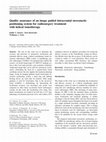
Journal of Neuro-Oncology, 2010
The aim of this work was to determine the accuracy and precision of stereotactic localization and... more The aim of this work was to determine the accuracy and precision of stereotactic localization and treatment delivery using a helical tomotherapy based stereotactic radiosurgery (SRS) system. A tomotherapy specific radiosurgery workflow was designed that exploits the system's on board megavotage CT (MVCT) imaging system so that it not only provides a pre-treatment volumetric verification image that can be used for stereotactic localization, eliminating the need for a patient-frame based coordinate system, but also supplies the treatment planning image. Using an imaging guidance based intracranial stereotactic positioning system, a head ring and tabletop docking device are used only for fixation, while image guidance is used for localization. Due to the unconventional workflow, a methodology for determining the localization accuracy was developed and results were compared to other linear accelerator based radiosurgery systems. In this work, the localization error using volumetric localization was found to be 0.45 mm ± 0.17 mm, indicating a localization precision of 0.3 mm within a 95% confidence interval. In addition, procedures for testing the delivery accuracy of the Tomotherapy system are described. Results show that the accuracy of the delivery can be verified to within ±1 voxel dimension. These results are well within conventional SRS tolerances and compare favorably to other linear accelerator based techniques.

Medical Physics, 2015
ABSTRACT To report on significant dose enhancement effects caused by magnetic fields aligned para... more ABSTRACT To report on significant dose enhancement effects caused by magnetic fields aligned parallel to 6MV photon beam radiotherapy of small lung tumors. Findings are applicable to future inline MRI-guided radiotherapy systems. 9 clinical lung plans were recalculated using Monte Carlo methods and external inline (parallel to the beam direction) magnetic fields of 0.5 T, 1.0 T and 3 T were included. Three plans were 6MV 3D-CRT and six were 6MV IMRT. The GTV's ranged from 0.8 cc to 73 cc, while the PTV ranged from 1 cc to 180 cc. The inline magnetic field has a moderate impact in lung dose distributions by reducing the lateral scatter of secondary electrons and causing a small local dose increase. Superposition of multiple small beams acts to superimpose the small dose increases and can lead to significant dose enhancements, especially when the GTV is low density. Two plans with very small, low mean density GTV's (<1 cc, ρ(mean)<0.35g/cc) showed uniform increases of 16% and 23% at 1 T throughout the PTV. Three plans with moderate mean density PTV's (3-13 cc, ρ(mean)=0.58-0.67 g/cc) showed 6% mean dose enhancement at 1 T in the PTV, however not uniform throughout the GTV/PTV. Replanning would benefit these cases. The remaining 5 plans had large dense GTV's (∼ 1 g/cc) and so only a minimal (<2%) enhancement was seen. In general the mean dose enhancement at 0.5 T was 60% less than 1 T, while 5-50% higher at 3 T. A paradigm shift in the efficacy of small lung tumor radiotherapy is predicted with future inline MRI-linac systems. This will be achieved by carefully taking advantage of the reduction of lateral electronic disequilibrium withing lung tissue that is induced naturally inside strong inline magnetic fields.

Practical Radiation Oncology, 2015
Stereotactic ablative body radiation therapy for primary kidney cancer treatment relies on motion... more Stereotactic ablative body radiation therapy for primary kidney cancer treatment relies on motion management that can quantify both the trajectory of kidney motion and stabilize the patient. A prospective ethics-approved clinical trial of stereotactic treatment to primary kidney targets was conducted at our institution. Our aim was to report on specific kidney tumor motion and the inter- and intrafraction motion as seen on treatment. Patients with tumor size <5 cm received a dose of 26 Gy in 1 fraction and those with tumor size ≥5 cm received 42 Gy in 3 fractions. All patients underwent a 4-dimensional computed tomography planning scan, immobilized in a dual-vacuum system. A conventional linear accelerator cone beam computed tomography scan was used for pre-, mid-, and posttreatment imaging to verify target position. Between July 2012 and October 2014, 33 targets from 32 consecutive patients (24 males/8 females) were treated. Seventeen targets were prescribed 26 Gy/1 fraction and the remaining 16 targets received 42 Gy/3 fractions. Kidney motion at each of the poles was not affected by the presence of tumor (P = .875), nor was the motion statistically different from the corresponding contralateral kidney pole (P = .909). The mean 3-dimensional displacement of the target at mid- and posttreatment was 1.3 mm (standard deviation ± 1.6) and 1.0 mm (standard deviation ± 1.3), respectively. The maximum displacement in any direction for 95% of the fractions at mid- and posttreatment was ≤3 mm. In summary, stereotactic ablative body radiation therapy of primary kidney targets can be accurately delivered on a conventional linear accelerator with protocol that has minimal intrafractional target motion.

PURPOSE Recent studies have shown that imaging procedures, such as cone-beam computed tomography ... more PURPOSE Recent studies have shown that imaging procedures, such as cone-beam computed tomography (CBCT), utilised in image-guided radiotherapy (IGRT) can add a significant dose to an already high therapeutic dose. This study aims to quantify this dose for a kilovoltage (kV) and a megavoltage (MV) CBCT acquired for breast radiotherapy image guidance. METHOD AND MATERIALS Dosimetry was performed using thermoluminescent dosimeters (TLDs) and metal-oxide-semiconductor-field-effect-transistor (MOSFETs) detectors. The dose to various organs and tissues specified by the International Commission on Radiation Protection, Publication 103, were measured with a female anthropomorphic phantom, see figure 1. The imaging dose from a kV CBCT and a MV CBCT unit acquired for patient setup during breast radiotherapy was determined. Additionally, the treatment dose from a left and right tangential breast radiotherapy treatment was measured to give a baseline to compare the additional imaging dose to. F...
Radiotherapy and Oncology, 2014

Journal of Thoracic Oncology, 2015
Lung tumor delineation is frequently performed using 3D positron emission tomography (PET)/comput... more Lung tumor delineation is frequently performed using 3D positron emission tomography (PET)/computed tomography (CT), particularly in the radiotherapy treatment planning position, by generating an internal target volume (ITV) from the slow acquisition PET. We investigate the dosimetric consequences of stereotactic ablative body radiotherapy (SABR) planning on 3D PET/CT in comparison with gated (4D) PET/CT. In a prospective clinical trial, patients with lung metastases were prescribed 26 Gy single-fraction SABR to the covering isodose. Contemporaneous 3D PET/CT and 4D PET/CT was performed in the same patient position. An ITV was generated from each data set, with the planning target volume (PTV) being a 5-mm isotropic expansion. Dosimetric parameters from the SABR plan derived using the 3D volumes were evaluated against the same plan applied to 4D volumes. Ten lung targets were evaluated. All 3D plans were successfully optimized to cover 99% of the PTV by the 26 Gy prescription. In all cases, the calculated dose delivered to the 4D target was less than the expected dose to the PTV based on 3D planning. Coverage of the 4D-PTV by the prescription isodose ranged from 74.48% to 98.58% (mean of 90.05%). The minimum dose to the 4D-ITV derived by the 3D treatment plan (mean = 93.11%) was significantly lower than the expected dose to ITV based on 3D PET/CT calculation (mean = 111.28%), p < 0.01. In all but one case, the planned prescription dose did not cover the 4D-PET/CT derived ITV. Target delineation using 3D PET/CT without additional respiratory compensation techniques results in significant target underdosing in the context of SABR.

International Journal of Radiation Oncology*Biology*Physics, 2015
To investigate (68)Ga-ventilation/perfusion (V/Q) positron emission tomography (PET)/computed tom... more To investigate (68)Ga-ventilation/perfusion (V/Q) positron emission tomography (PET)/computed tomography (CT) as a novel imaging modality for assessment of perfusion, ventilation, and lung density changes in the context of radiation therapy (RT). In a prospective clinical trial, 20 patients underwent 4-dimensional (4D)-V/Q PET/CT before, midway through, and 3 months after definitive lung RT. Eligible patients were prescribed 60 Gy in 30 fractions with or without concurrent chemotherapy. Functional images were registered to the RT planning 4D-CT, and isodose volumes were averaged into 10-Gy bins. Within each dose bin, relative loss in standardized uptake value (SUV) was recorded for ventilation and perfusion, and loss in air-filled fraction was recorded to assess RT-induced lung fibrosis. A dose-effect relationship was described using both linear and 2-parameter logistic fit models, and goodness of fit was assessed with Akaike Information Criterion (AIC). A total of 179 imaging datasets were available for analysis (1 scan was unrecoverable). An almost perfectly linear negative dose-response relationship was observed for perfusion and air-filled fraction (r(2)=0.99, P<.01), with ventilation strongly negatively linear (r(2)=0.95, P<.01). Logistic models did not provide a better fit as evaluated by AIC. Perfusion, ventilation, and the air-filled fraction decreased 0.75 ± 0.03%, 0.71 ± 0.06%, and 0.49 ± 0.02%/Gy, respectively. Within high-dose regions, higher baseline perfusion SUV was associated with greater rate of loss. At 50 Gy and 60 Gy, the rate of loss was 1.35% (P=.07) and 1.73% (P=.05) per SUV, respectively. Of 8/20 patients with peritumoral reperfusion/reventilation during treatment, 7/8 did not sustain this effect after treatment. Radiation-induced regional lung functional deficits occur in a dose-dependent manner and can be estimated by simple linear models with 4D-V/Q PET/CT imaging. These findings may inform future studies of functional lung avoidance using V/Q PET/CT.

International Journal of Radiation Oncology*Biology*Physics, 2015
Measuring changes in lung perfusion resulting from radiation therapy dose requires registration o... more Measuring changes in lung perfusion resulting from radiation therapy dose requires registration of the functional imaging to the radiation therapy treatment planning scan. This study investigates registration accuracy and utility for positron emission tomography (PET)/computed tomography (CT) perfusion imaging in radiation therapy for non-small cell lung cancer. (68)Ga 4-dimensional PET/CT ventilation-perfusion imaging was performed before, during, and after radiation therapy for 5 patients. Rigid registration and deformable image registration (DIR) using B-splines and Demons algorithms was performed with the CT data to obtain a deformation map between the functional images and planning CT. Contour propagation accuracy and correspondence of anatomic features were used to assess registration accuracy. Wilcoxon signed-rank test was used to determine statistical significance. Changes in lung perfusion resulting from radiation therapy dose were calculated for each registration method for each patient and averaged over all patients. With B-splines/Demons DIR, median distance to agreement between lung contours reduced modestly by 0.9/1.1 mm, 1.3/1.6 mm, and 1.3/1.6 mm for pretreatment, midtreatment, and posttreatment (P<.01 for all), and median Dice score between lung contours improved by 0.04/0.04, 0.05/0.05, and 0.05/0.05 for pretreatment, midtreatment, and posttreatment (P<.001 for all). Distance between anatomic features reduced with DIR by median 2.5 mm and 2.8 for pretreatment and midtreatment time points, respectively (P=.001) and 1.4 mm for posttreatment (P>.2). Poorer posttreatment results were likely caused by posttreatment pneumonitis and tumor regression. Up to 80% standardized uptake value loss in perfusion scans was observed. There was limited change in the loss in lung perfusion between registration methods; however, Demons resulted in larger interpatient variation compared with rigid and B-splines registration. DIR accuracy in the data sets studied was variable depending on anatomic changes resulting from radiation therapy; caution must be exercised when using DIR in regions of low contrast or radiation pneumonitis. Lung perfusion reduces with increasing radiation therapy dose; however, DIR did not translate into significant changes in dose-response assessment.
ABSTRACT Purpose: To explore the feasibility of pretreatment test for iso-NTCP DGART and to compa... more ABSTRACT Purpose: To explore the feasibility of pretreatment test for iso-NTCP DGART and to compare the pretreatment test results with post-treatment evaluations.
This study investigates the dose from the 1 mm collimator width megavoltage fan-beam CT (fine, no... more This study investigates the dose from the 1 mm collimator width megavoltage fan-beam CT (fine, normal and coarse pitch) available on tomotherapy as well as for whole-breast tomotherapy treatments. The BEIR VII lifetime attributable risk model was utilised to assess the significance of the imaging dose relative to the treatment dose.
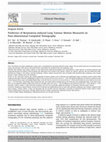
Clinical Oncology, 2014
Aims: The delivery of radical radiotherapy in lung cancer is complicated by respiratory-induced t... more Aims: The delivery of radical radiotherapy in lung cancer is complicated by respiratory-induced tumour motion. The aim of the study was to correlate tumour motion characteristics with tumour and patient factors, particularly the anatomical lobe and pulmonary zone. Materials and methods: Lung tumour volumes on four-dimensional computed tomography were delineated by a single observer at maximal expiration and propagated through all 10 phases of the breathing cycle. Movements were tracked in the superioreinferior (SI), anterioreposterior (AP) and medio-lateral (ML) directions by changes in the tumour centroid coordinates. Tumour motion characteristics were correlated with anatomical lobe, pulmonary zone, tumour volume, T-stage, smoking status and spirometry. Results: In 101 consecutive patients, the median magnitude of tumour motion in the SI direction was significantly larger in tumours located in lower lobes compared with upper lobes and middle/lingular lobes (0.70 cm versus 0.09 cm versus 0.26 cm, P < 0.01). No significant difference was found in median tumour motion between lower, upper and middle/lingular lobes in the AP (0.16 cm versus 0.13 cm versus 0.16 cm, P ¼ 0.45) and ML (0.08 cm versus 0.08 cm versus 0.13 cm, P ¼ 0.32) directions, respectively. When assessed by zone, the median tumour displacement in the SI direction was significantly larger in the lower zones (0.81 cm) as compared with the middle zones (0.30 cm) and upper zones (0.11 cm), P < 0.01. No difference was observed in the AP (P ¼ 0.45) and ML (P ¼ 0.73) directions. Tumour volume, T-stage and forced expiratory ratio were not statistically significant predictors of respiratory-induced tumour motion. Conclusion: Respiratory-induced tumour motion in the SI direction was significantly greater in lower lobe and lower pulmonary zone tumours compared with apical tumours. Tumour volume, T-stage and spirometry did not correlate with the magnitude or direction of respiratory-induced tumour motion. During curative radiotherapy in lung cancer, attention should be paid to motion management, especially for lower lobe tumours.
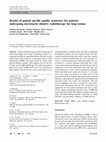
Australasian Physical & Engineering Sciences in Medicine, 2014
Hypofractionated image guided radiotherapy of extracranial targets has become increasingly popula... more Hypofractionated image guided radiotherapy of extracranial targets has become increasingly popular as a treatment modality for inoperable patients with one or more small lesions, often referred to as stereotactic ablative body radiotherapy (SABR). This report details the results of the physical quality assurance (QA) program used for the first 33 lung cancer SABR radiotherapy 3D conformal treatment plans in our centre. SABR involves one or few fractions of high radiation dose delivered in many small fields or arcs with tight margins to mobile targets often delivered through heterogeneous media with non-coplanar beams. We have conducted patient-specific QA similar to the more common intensity modulated radiotherapy QA with particular reference to motion management. Individual patient QA was performed in a Perspex phantom using point dose verification with an ionisation chamber and radiochromic film for verification of the dose distribution both with static and moving detectors to verify motion management strategies. While individual beams could vary by up to 7 %, the total dose in the target was found to be within ±2 % of the prescribed dose for all 33 plans. Film measurements showed qualitative and quantitative agreement between planned and measured isodose line shapes and dimensions. The QA process highlighted the need to account for couch transmission and demonstrated that the ITV construction was appropriate for the treatment technique used. QA is essential for complex radiotherapy deliveries such as SABR. We found individual patient QA helpful in setting up the technique and understanding potential weaknesses in SABR workflow, thus providing confidence in SABR delivery.
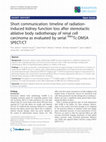
Radiation oncology (London, England), Jan 26, 2014
BackgroundStereotactic ablative body radiotherapy (SABR) has been proposed as a definitive treatm... more BackgroundStereotactic ablative body radiotherapy (SABR) has been proposed as a definitive treatment for patients with inoperable primary renal cell carcinoma. However, there is little documentation detailing the radiobiological effects of hypofractionated radiation on healthy renal tissue.FindingsIn this study we describe a methodology for assessment of regional change in renal function in response to single fraction SABR of 26Gy. In a patient with a solitary kidney, detailed follow-up of kidney function post-treatment was determined through 3-dimensional SPECT/CT imaging and 51Cr-EDTA measurements. Based on measurements of glomerular filtration rate, renal function declined rapidly by 34% at 3 months, plateaued at 43% loss at 12 months, with minimal further decrease to 49% of baseline by 18 months.ConclusionsThe pattern of renal functional change in 99mTc-DMSA uptake on SPECT/CT imaging correlates with dose delivered. This study demonstrates a dose effect relationship of SABR with...
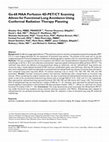
Technology in cancer research & treatment, Jan 9, 2015
Ga-68-macroaggregated albumin ((68)Ga-perfusion) positron emission tomography/computed tomography... more Ga-68-macroaggregated albumin ((68)Ga-perfusion) positron emission tomography/computed tomography (PET/CT) is a novel imaging technique for the assessment of functional lung volumes. The purpose of this study was to use this imaging technique for functional adaptation of definitive radiotherapy plans in patients with non-small cell lung cancer (NSCLC). This was a prospective clinical trial of patients with NSCLC who received definitive 3-dimensional (3D) conformal radiotherapy to 60 Gy in 30 fx and underwent pretreatment respiratory-gated (4-dimensional [4D]) perfusion PET/CT. The "perfused" lung volume was defined as all lung parenchyma taking up radiotracer, and the "well-perfused" lung volume was contoured using a visually adapted threshold of 30% maximum standardized uptake value (SUVmax). Alternate 3D conformal plans were subsequently created and optimized to avoid perfused and well-perfused lung volumes. Functional dose volumetrics were compared using mean ...

Technology in Cancer Research and Treatment, 2013
Since delivered dose is rarely the same with planned, we calculated the delivered total dose to t... more Since delivered dose is rarely the same with planned, we calculated the delivered total dose to ten prostate radiotherapy patients treated with rectal balloons using deformable dose accumulation (DDA) and compared it with the planned dose. The patients were treated with TomoTherapy using two rectal balloon designs: five patients had the Radiadyne balloon (balloon A), and five patients had the EZ-EM balloon (balloon B). Prostate and rectal wall contours were outlined on each pre-treatment MVCT for all patients. Delivered fractional doses were calculated using the MVCT taken immediately prior to delivery. Dose grids were accumulated to the last MVCT using DDA tools in Pinnacle3 TM (v9.100, Philips Radiation Oncology Systems, Fitchburg, USA). Delivered total doses were compared with planned doses using prostate and rectal wall DVHs. The rectal NTCP was calculated based on total delivered and planned doses for all patients using the Lyman model. For 8/10 patients, the rectal wall NTCP calculated using the delivered total dose was less than planned, with seven patients showing a decrease of more than 5% in NTCP. For 2/10 patients studied, the rectal wall NTCP calculated using total delivered dose was 2% higher than planned. This study indicates that for patients receiving hypofractionated radiotherapy for prostate cancer with a rectal balloon, total delivered doses to prostate is similar with planned while delivered dose to rectal walls may be significantly different from planned doses. 8/10 patients show significant correlation between rectal balloon anterior-posterior positions and some VD values.
Medical Physics, 2011
Purpose: This study explores the methodology of determining accumulated delivered dose using defo... more Purpose: This study explores the methodology of determining accumulated delivered dose using deformable registration. The aim of the study was to examine the inter‐fraction variation of dose delivered to the patient and to compare the voxel‐by‐voxel accumulated dose with the planned dose. Methods: Five prostate patients treated with a rectal balloon using the same 12‐fraction Hi‐Art Tomotherapy technique were studied. The dose was calculated on the pre‐treatment MVCT images of each fraction. All 12 dose grids were ...
Uploads
Papers by Nicholas Hardcastle